Meal kit market may have peaked
Meal kits are to food what IKEA is to furniture. All you need to do is put things together. Meal kits empower consumers to feel like chefs, if only for a while. They have been popular, especially throughout the pandemic. Meal kits provide ideas, ways to manage your meals and some greatly needed inspiration for households running out of options for lunches and dinners. But over the last few weeks, we’ve been seeing signs that, perhaps, meal kit use has peaked in Canada.
For the most part, Canadians have got their normal lives back and have become nomads again, which means spending less time in the kitchen. According to a recent survey conducted by Dalhousie University in partnership with Caddle, 8.4% of Canadians subscribe to a meal kit service provider today. That is down from 12.8% in November 2020, when we were several months into the pandemic. While 69.1% of Canadians have never subscribed to any meal kit service, 22.5% have ceased to use a meal kit service and only 3% are now fully committed to a meal kit provider and expect to continue to use the service. Another 9.8% of Canadians believe they may use meal kits in the future, but remain unsure. Those percentages are very low. Retention of customers has clearly become an issue with these services.
The biggest users of meal kits (rate of usage) are gen Zs at 14.5%, followed by millennials at 12.1%, gen-Xers at 7.9% and finally baby boomers, at a measly 3.2%. Amongst provinces, the highest usage rate right now is in British Columbia, at 10.4%, followed by Quebec at 9.3%, and Alberta at 9%. Ontario is at 8.4%, the national average. The lowest rate in the country is in Manitoba, at 4.5%.
Of Canadians using meal kits today, only 15.8% of them had never ordered meal kits before the pandemic. Given that the market was inundated with rebates and coupons for months to get consumers hooked on some of these services, that percentage is strikingly low. For a while, many meal kit providers were partially subsidizing their own demand, which is why accessing true market loyalty towards these programs was challenging. Also, 66.1% of these consumers are fully committed to meal kits as they use them either daily or weekly. The main factors for why Canadians order meal kits are for convenience (57.7%), to save time (30.4%), and to avoid planning meals (15.4%). HelloFresh remains the most popular service at 32% followed by Goodfood at 24.6%. Chef’s Plate, owned by HelloFresh, is third at 14.9%.
Estimates from the Agri-Food Analytics Lab suggest that the meal kit market in Canada is likely worth about $1.1 billion today, compared to barely $5 million, more than a decade ago. That is quite an accomplishment. At its peak though, back in 2020, the market surpassed $1.5 billion.
The factors that seem to be pushing consumers away from meal kits are the price, and the heavy, unsustainable packaging that comes with the delivered meals. The average price per meals is typically anywhere between $8 to $13 per meal, per person, and you still have to prepare the meal before enjoying it, and clean up afterwards. A total of 78.1% of consumers who have dropped the service felt the prices were too high. As for packaging issues, 67.5% dropped the service due to the overwhelming packaging. And with the cost of food these days, it is highly unlikely prices will drop anytime soon.
Grocers have also gotten better at delivering food to consumers’ homes. Some are offering meal kits themselves in different forms. The retention rate for customers of online grocery sites is also typically much higher. Online grocery shoppers will go back to buying more food online, more than 80% of the time, according to NielsenIQ. That retention rate is intimidating for meal kit providers. Loyalty is undoubtedly in our grocers’ favour. We could see more meal kits offered by grocers themselves or even restaurant chains using our grocers’ distribution network to reach us, physically or virtually.
Some Canadians will remain committed to meal kits. You are likely to waste less food and eat healthier, for the most part. But the industry is facing major headwinds as the economy trends back to normal The path to growth is unclear at this point. What’s more worrisome, the cost of food will also be a challenge for meal kit providers struggling to keep costs in check during these turbulent times.




